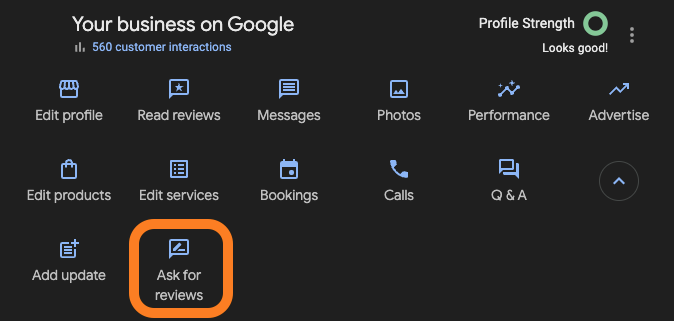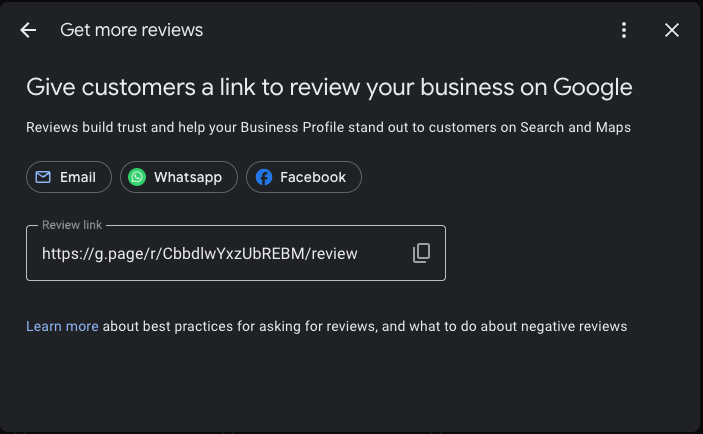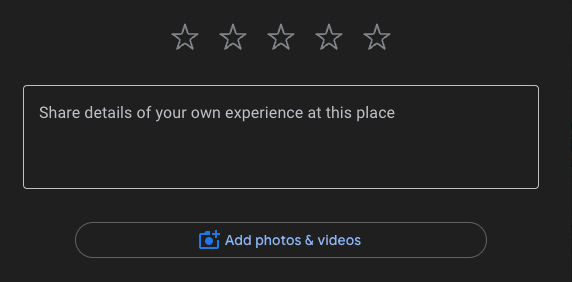No business outranks a bad reputation.
If your business doesn’t have a review-building strategy in place, you’re on shaky ground. Even with phenomenal products and service, you’re only ever one embittered customer away from a one-star review that risks tarnishing your reputation—especially if you don’t have an abundance of positive reviews to offset that single star.
What’s more, Google tells us directly,
High-quality, positive reviews from your customers can improve your business visibility and increase the likelihood that a shopper will visit your location.
Not only do reviews impact user behavior once they find your business, but they also influence the three primary local ranking factors: relevance, distance, and prominence.
With a favorable review profile, your business will get found more, land more customers, and protect itself from rogue agents who are all too eager to shoot off a single star.
Since reviews are so crucial for local businesses, what can you do to get more? We’ll start off with what you should never do and work through 11 practical tips to bolster your review profile—plus, you’ll find the single best thing you can do for your local visibility at the end of this article.
Two Things You Should Never Do to Get More Reviews
Google’s guidelines rail against fake engagement. For review purposes, this boils down to two main tactics: incentivizing customers for reviews and review-gating. (By the way, we’re going to assume you’d never pay for fake reviews, so we’re leaving that off…)
1. Never incentivize customers to leave a review.
You might want to make a good-faith offer to customers who’ve had a positive experience. Sounds harmless enough, right? Don’t do it. You can’t offer current or past clients a discount, prize, raffle, gift card, or any other incentive to leave a review. Google does not consider such review content as representing a genuine experience.
2. Don’t gate reviews.
Google’s guidelines do not allow “discourag[ing] or prohibit[ing] negative reviews, or selectively solicit[ing] positive reviews from customers.” Essentially, if you are pre-screening reviews and discouraging anyone from leaving negative feedback, you are review-gating. If you are using software to pre-score customer sentiment, you must ensure that the link to review is available regardless of the customer’s pre-review rating. If the option to review is not available after a customer scores in a certain range, this could be construed as review-gating.
With these don’ts out of the way, let’s jump into the actionable tips to help you source more reviews from your customers.
11 Ways to Get More Reviews on Google
1. Make it easy for customers to leave reviews.
This might sound like a throwaway tip, but how easy is it really for customers to leave a review for your business? Do they have to track down your business on Google or Yelp or Facebook, and then proceed through the review process? A devoted (or disgruntled) customer just might jump through hoops to leave you a review, but the average customer likely won’t.
Use the review link for your Google Business Profile to make it easy for your customers to leave a review. Go to your GBP options and hit “Ask for reviews.”
There you’ll find a link that takes anyone who clicks directly to a dialog box where they can rate and review your business.
The neat and tidy link:
Where the link leads:
That’s a powerful link! Try a URL shortener or create a QR code, and put that link in any number of places where your customers might find it, click it, scan it, and review it. (More on this below!)
2. Ask in person.
Never underestimate the power of an in-person ask. If you are interacting with customers face to face, just ask! You don’t have to pressure them or make them feel forced. Give them the option, and even consider providing them a tool to do it—perhaps on a tablet or phone that’s easily accessible or that you can pass over. Having a screen available where customers can opt to leave a review is fine too, but you’ll notice the quantity of your reviews skyrocket as soon as you start making face-to-face asks.
3. Utilize QR codes in your store or office.
If you have foot traffic to your business, try using the link mentioned in the first tip to create a QR code. Once you have a QR code, you can use it in a number of places, first and foremost your brick-and-mortar office. It doesn’t have to be cliche or tacky. You can easily find nicely designed placards or stands to display the QR code.
You might also consider using near-field communication (NFC) so that customers can tap to review rather than scan. Pulling up the camera to scan the QR code isn’t a big deal, but NFC’s tap functionality enables customers to head right to reviewing by omitting the camera.
4. Send emails.
If you collect customer contact information, use that data to benefit your review profile. Try sending emails that clearly ask for reviews. You might try to send emails yourself, but realistically, you’ll want a third-party review platform like GatherUp, which can automate the process for you. Our friends at BrightLocal also offer robust reputation management software that allows businesses to scale review requests and generation.
Just remember: If you use software to ask for reviews, ensure that you are not unwittingly practicing review-gating. Gating reviews violates Google’s guidelines.
5. Try text messages.
Depending on your demographic, you might see better review completion rates with text messages. If you’re not quite sure which is better, try both email and text. Just don’t overwhelm your customers with too many asks and marketing communication. That’s not going to help your case when you’re trying to get more reviews on Google.
6. Use leave-behinds.
If your business visits customers’ homes, try a leave-behind that asks for a review. If you leave a brochure, folder, note, or business card, you might even consider embedding a small QR code that takes customers straight to your Google Business Profile to write a review.
We’ve noticed that handwritten notes actually do better than more generic printouts. You’re not going to hand-draw a QR code, but you might use letterhead that includes the QR code with space for a handwritten note.
7. Incentivize your team.
You can’t incentivize your customers to leave reviews, but you can definitely incentivize your team to ask customers for reviews. Rewards can go a long way in motivating staff to ask for and land more reviews. Set realistic goals based on your current review rate and reward accordingly for meeting and exceeding those metrics.
8. Display your review link on your website.
You’ll want to maximize the publicity of that Google review link from tip #1, including on your website. If you have a testimonials section on your website already, that’s a great place to invite customers to leave reviews. You might also consider placing your review link in your footer so that it’s available across all your pages. Wherever you place it, ensuring that it’s available on your website will inevitably help you source more reviews.
RicketyRoo Pro Tip: You might consider creating a page on your website explicitly asking for reviews. You may not expect many visitors to that page, but you can utilize that link, example.com/leave-a-review, to send customers. That page might have a bit of copy that makes a heartfelt ask and then leads people to leave a review on Google.
9. Respond to every review.
Google encourages businesses to respond to reviews: “Customers will notice your business values their input if you read and reply to their reviews.” Replying to all reviews is essential, but responding to negative reviews is incredibly crucial. Not only do negative reviews offer you an opportunity to make things right, but they also give you a chance to show prospective customers how you handle disgruntled customers. Take ownership of their experience, and offer to make it right.
There’s no evidence that responding to reviews (and including keywords in those responses!) directly boosts rankings. But any opportunity you have to interact with customers and demonstrate how you value them is a win! Considering that user signals do impact rankings, replying to reviews may indirectly impact your business’s visibility by encouraging users to engage longer with your profile.
10. Practice good business.
This isn’t a throwaway tip: You have to be 5 stars before you can get 5 stars.
Before you start earnestly asking for reviews, you need to ensure that your business is doing right by your customers. You don’t have to be perfect, but ask yourself this question: Is my business worth the five stars I’m hoping to receive from reviewers?
Scrutinize your practices, especially from your customers’ perspective. Is your competition doing anything that customers enjoy more? What, if anything is stopping you from delivering a 5-star experience? Don’t go easy on yourself! Strive to be the 5-star business you want your customers to perceive you are.
11. Keep on asking.
Playing the long game is essential to getting more reviews for your local business. If you’ve neglected regularly asking for reviews to this point, start small; don’t blast your entire customer list with texts and emails right away. Start with a subset of your customer list and keep plugging away.
If at first you don’t see as much success as you’d hoped, keep on asking. Try a few different strategies. Try all of them, even! Just be sure you don’t overwhelm your customers with too many asks. You might end up depleting their patience and backfire on your strategy!
Should I Source Reviews Beyond Google?
You should always prioritize collecting more reviews on your Google Business Profile. It’s very likely the platform where you have the highest chance at the most visibility; it makes sense to focus a lot of your attention on your GBP.
You shouldn’t limit yourself to asking for reviews via your GBP. Search for your primary keywords. Do any platforms show up on the first page that allow reviews? Depending on your niche, you’ll see a variety of directory platforms that likely source reviews. If your business provides home services, you’ll probably want to check out Angi and HomeAdvisor. If you’re more of a destination, you might see TripAdvisor rank high. Facebook is another place to prioritize.
If Yelp is on your list, just keep in mind that asking for reviews is against their guidelines.
Better Business for More Google Reviews
If you’ve made it this far, then you deserve to know the number one secret to getting more Google reviews. There’s no question that this single tip is going to make the biggest difference in your review-gathering strategy.
Are you ready?
Be a better business.
All right, the joke’s on us because we basically already said that in tip #11 🙃.
But seriously: the bottom line is that good businesses get good reviews.
Don’t hear us saying that you’re not a good business if you don’t have a certain number of 5-star ratings. Specific niches may not lend themselves to a high review velocity. Still, considering reviews affords you the opportunity to think like your customers and optimize from their point of view.
You’re probably already running a great business. But there’s always something that can be improved. Take things a step at a time, and let your quest for more reviews motivate you to make your business genuinely worthy of a 5-star rating.
Ready to wrangle more reviews?
Schedule a discovery call with RicketyRoo
and discover how we can improve your reputation management.






